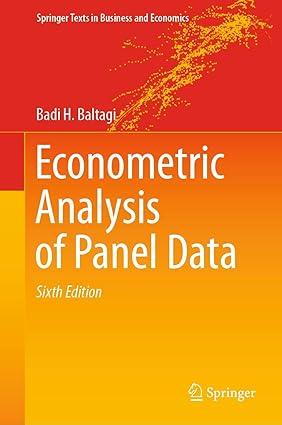Three-way error component model. Ghosh (1976) considered the following error component model: [u_{i t q}=mu_{i}+lambda_{t}+eta_{q}+u_{i t q}]
Question:
Three-way error component model. Ghosh (1976) considered the following error component model:
\[u_{i t q}=\mu_{i}+\lambda_{t}+\eta_{q}+u_{i t q}\]
where \(i=1, \ldots, N ; T=1, \ldots, T\); and \(q=1, \ldots, M\). Ghosh (1976) argued that in international or interregional studies, there might be two rather than one cross-sectional component; for example, \(i\) might denote countries and \(q\) might be regions within that country. These four independent error components are assumed to be random with \(\mu_{i} \sim \operatorname{IID}\left(0, \sigma_{\mu}^{2}ight), \lambda_{t} \sim \operatorname{IID}\left(0, \sigma_{\lambda}^{2}ight), \eta_{q} \sim \operatorname{IID}\left(0, \sigma_{\eta}^{2}ight)\) and \(u_{i t q} \sim \operatorname{IID}\left(0, \sigma_{u}^{2}ight)\). Order the observations such that the faster index is \(q\), while the slowest index is \(t\), so that
\[\begin{aligned}u^{\prime}= & \left(u_{111}, \ldots, u_{11 M}, u_{121}, \ldots, u_{12 M}, \ldots, u_{1 N 1}, \ldots,ight. \\& \left.u_{1 N M}, \ldots, u_{T 11}, \ldots, u_{T 1 M}, \ldots, u_{T N 1}, \ldots, u_{T N M}ight)\end{aligned}\]
(a) Show that the error has mean zero and variance-covariance matrix
\[\begin{aligned}\Omega= & E\left(u u^{\prime}ight)=\sigma_{u}^{2}\left(I_{T} \otimes I_{N} \otimes I_{M}ight)+\sigma_{\lambda}^{2}\left(I_{T} \otimes J_{N} \otimes J_{M}ight) \\& +\sigma_{\mu}^{2}\left(J_{T} \otimes I_{N} \otimes J_{M}ight)+\sigma_{\eta}^{2}\left(J_{T} \otimes J_{N} \otimes I_{M}ight)\end{aligned}\]
(b) Using the Wansbeek and Kapteyn (1982b) trick, show that \(\Omega=\sum_{j=1}^{5} \xi_{j} V_{j}\) where \(\xi_{1}=\sigma_{u}^{2}, \xi_{2}=N M \sigma_{\lambda}^{2}+\sigma_{u}^{2}, \xi_{3}=T M \sigma_{\mu}^{2}+\sigma_{u}^{2}, \xi_{4}=N T \sigma_{\eta}^{2}+\sigma_{u}^{2}\), and \(\xi_{5}=N M \sigma_{\lambda}^{2}+T M \sigma_{\mu}^{2}+N T \sigma_{\eta}^{2}+\sigma_{u}^{2}\). Also
\[\begin{aligned}V_{1}= & I_{T} \otimes I_{N} \otimes I_{M}-I_{T} \otimes \bar{J}_{N} \otimes \bar{J}_{M}-\bar{J}_{T} \otimes I_{N} \otimes \bar{J}_{M} \\& -\bar{J}_{T} \otimes \bar{J}_{N} \otimes I_{M}+2 \bar{J}_{T} \otimes \bar{J}_{N} \otimes \bar{J}_{M} \\V_{2}= & E_{T} \otimes \bar{J}_{N} \otimes \bar{J}_{M} \quad \text { where } \quad E_{T}=I_{T}-\bar{J}_{T} \\V_{3}= & \bar{J}_{T} \otimes E_{N} \otimes \bar{J}_{M} \\V_{4}= & \bar{J}_{T} \otimes \bar{J}_{N} \otimes E_{M} \quad \text { and } V_{5}=\bar{J}_{T} \otimes \bar{J}_{N} \otimes \bar{J}_{M}\end{aligned}\]
all symmetric and idempotent and sum to the identity matrix.
(c) Conclude that \(\Omega^{-1}=\sum_{j=1}^{5}\left(1 / \xi_{j}ight) V_{j}\) and \(\sigma_{u} \Omega^{-1 / 2}=\sum_{j=1}^{5}\left(\sigma_{u} / \sqrt{\xi_{j}}ight) V_{j}\) with the typical element of \(\sigma_{u} \Omega^{-1 / 2} y\) being
\[y_{t i q}-\theta_{1} \bar{y}_{t . .}-\theta_{2} \bar{y}_{. i .}-\theta_{3} \bar{y}_{. . q}-\theta_{4} \bar{y}_{\ldots}\]
where the dot indicates a sum over that index and a bar means an average. Here, \(\theta_{j}=1-\sigma_{u} / \sqrt{\xi_{j+1}}\) for \(j=1,2,3\) while \(\theta_{4}=\theta_{1}+\theta_{2}+\theta_{3}-1+\) \(\left(\sigma_{u} / \sqrt{\xi_{5}}ight)\).
(d) Show that the BQU estimator of \(\xi_{j}\) is given by \(u^{\prime} V_{j} u / \operatorname{tr}\left(V_{j}ight)\) for \(j=1,2,3,4\). Show that BQU estimators of \(\sigma_{u}^{2}, \sigma_{\mu}^{2}, \sigma_{\eta}^{2}\), and \(\sigma_{\lambda}^{2}\) can be obtained using the one-to-one correspondence between the \(\xi_{j}\) and \(\sigma^{2}\).
This problem is based on Baltagi (1987). For a generalization of this fourcomponent model as well as an alternative class of decompositions of the variance-covariance matrix, see Wansbeek and Kapteyn (1982a), and also Davis (2002) who gives an elegant generalization to the multi-way unbalanced error component model;
Step by Step Answer:






